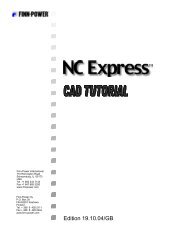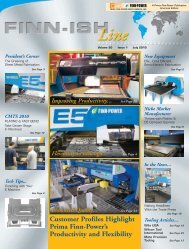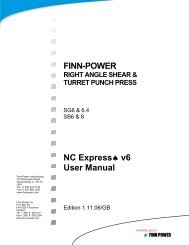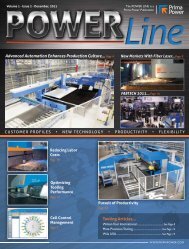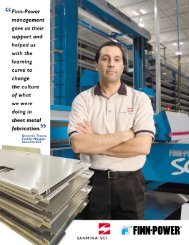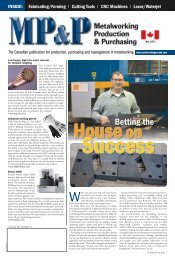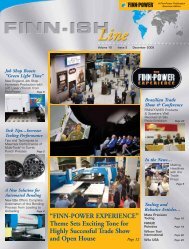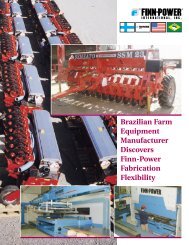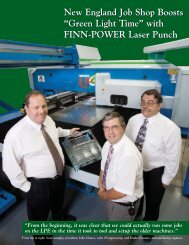Stand-Alone Punch machine user manual - Finn-Power International ...
Stand-Alone Punch machine user manual - Finn-Power International ...
Stand-Alone Punch machine user manual - Finn-Power International ...
Create successful ePaper yourself
Turn your PDF publications into a flip-book with our unique Google optimized e-Paper software.
5.2.3 Template Turret<br />
Template turret allows the ability to specify a turret before creating a plate. Once a<br />
template turret has been selected for the nest, the selected turret will be used for<br />
optimization and post processing. This is useful when multiple turrets have been<br />
created. If a nest is being created with parts that share the same turret the actual<br />
turret should not need to be selected from Template Turret.<br />
5.2.4 Nest Direction<br />
Nest Direction determines the starting position of placement of parts in a sequence.<br />
When nesting parts, the parts are placed on the plate one at a time. So, the nest<br />
direction position chosen within the dialog will determine the starting point of the<br />
nest and work its way from the specified location to fill out the plate. For example,<br />
if upper left is chosen the first part will be placed in the upper left corner of the<br />
plate and will fill out the rest of the sheet from there.<br />
Typically for all <strong>Finn</strong>-<strong>Power</strong> <strong>machine</strong>s upper left corner is used because this is the<br />
side closest to the sheet removal when plate is being processed at the <strong>machine</strong>.<br />
Other directions can be utilized to find a more suitable nest outcome.<br />
5.2.5 Nest in Zones<br />
Splits parts into separate reposition zones if needed.<br />
5.2.6 Grid Nesting<br />
Grid Nesting is used to nest parts in a grid like manner. The parts are arranged<br />
within the plate in a uniform fashion. When using this option the part quantities<br />
may change within the plate. Grid Nesting will allow for a better looking nest and<br />
is generally well suited for use with square or rectangular parts.<br />
5.2.7 Nest by Work Order<br />
If parts are nested using a work order number the parts can be sorted within the<br />
plate(s) by the work order entered. Work order’s can be used in nesting by either<br />
entering the work order when adding the part to the part list or by utilizing Orders<br />
database.<br />
5.2.8 Nest in Holes<br />
Within NC Express’ nesting engine Nest in Holes allows parts to be nested within a<br />
cutout of another part. If a nest has small parts that will be nested along with large<br />
parts with cutouts big enough for the small parts to fit, Nest in Holes activated will<br />
nest the small parts within the cutouts. Requirement of Nest in Holes is that the<br />
cutout is to be microjointed (tabbed) into place.<br />
5.3 Part Rotation (Grain Restriction)<br />
When a part is first created the nest rotation is set. There are two different nest<br />
rotation options- 0/180 and 90/270. Activating either one of the nest rotations within<br />
the part properties will allow the part to rotate when nesting. Even though the part<br />
5-83




